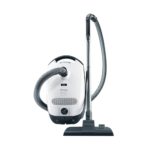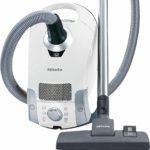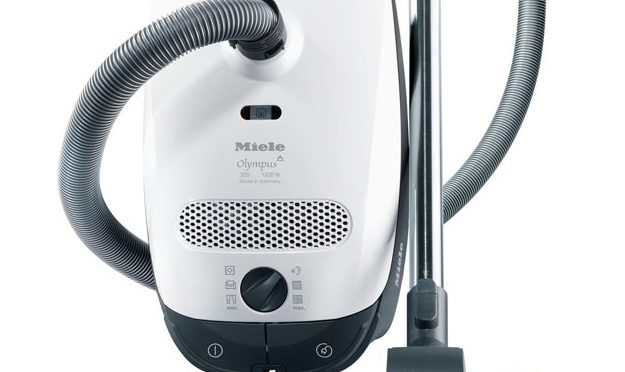We sometimes get carried away reviewing vacuums that cost more than many people’s mortgages. While the Complete C3 Cat & Dog may be our favorite vacuum for homes with pets and the Complete C3 Soft Carpet remains our top choice for homes with soft, hand-made, or high-pile carpeting, it’s easy to forget that for many people in the US or Canada, a $300 vacuum cleaner is already a significant–perhaps even shockingly high–expense. As a result, today we’ll take a look at the best value family canister vacuums on the market. Right now, in our books, those are the Miele Classic C1 Olympus and the Miele Compact C1 Pure Suction. While both of these are among the cheapest vacuums Miele sells, either of these vacuums is easily capable of being the only vacuum the average family might ever need. If you’re stuck deciding between the two of them but ready to buy, we recommend the Classic C1 Olympus, and you can buy it here.
 The Classic C1 Olympus and the Compact C1 Pure Suction Are Rather Similar.
The Classic C1 Olympus and the Compact C1 Pure Suction Are Rather Similar.
When it comes down to it, the Classic C1 Olympus and the Compact C1 Pure Suction are similar in a lot of ways. They both feature the same 1,200 watt Vortex motor Miele supplies in all of their canister vacuums. They both come with the same set of accessories–the dusting brush, the upholstery tool, and the crevice tool. They both come with six power control settings including the quiet setting that lets you vacuum with sleeping babies in the next room (yes, we’ve tried and confirmed this ability with each Miele that comes with the feature; it works!). They both come with exactly the same cleaning radius at 29.5 feet (which includes the power cord, the air hose, and the telescopic wand). They both feature an AirClean System for air and dirt filtration that Miele claims capable of removing 99.9% of lung irritants. Both feature a telescopic stainless steel wand and both are sparkling white and rather lightweight (although the Classic C1 at just under 13 pounds is the lighter of the two compared to the Compact C1, which clocks in at just under 15 pounds). So far, it doesn’t sound like there’s much differentiating the two besides their names and the fact that the Classic C1 weighs a little less. Let’s keep looking.
 The Classic C1 and Compact C1 are Meant For Smooth Flooring and Low-Pile Carpeting
The Classic C1 and Compact C1 are Meant For Smooth Flooring and Low-Pile Carpeting
Because both come with a standard combination floor tool (the SBD 350-3 Classic FiberTeQ tool in the Classic C1 and the STB 285-3 AllTeQ Combination Floorhead in the Compact C1), both are best suited to hardwood and other smooth flooring. They can each handle low-pile carpeting (i.e., the default carpeting found in homes and apartments throughout the United States and Canada), but aren’t going to do much of anything on medium-pile carpeting and will be completely helpless on high-pile carpeting (the cheapest current Miele capable of tackling high-pile carpeting is the Compact C2 Electro+, while the cheapest Miele for medium-pile carpet work is the Complete C2 Limited). To be frank, cleaning power between the two vacuums is more or less the same; we didn’t notice a significant difference in the long term between the two. It’s just important to remember that both vacuums are primarily designed for smooth flooring first and low-pile carpeting second; if you’ve got low-pile area rugs, you’ll also be fine. However, if you’ve got high-end or handmade rugs or carpeting, you’ll want to pony up the extra dollars for one of the higher-end Mieles to avoid disappointment.
…but the Classic C1 is More Environmentally Friendly and Cheaper to Maintain
However, because the C1 comes with a larger dirt bag, you’re going to spend less money in the long term buying replacement bags and less time overall replacing the bags, since each will take longer to fill up. This is hinted at by the fact that the Compact C1 is marketed as a compact version of the entry line C1. The specific bag differences are 4.7 quarts in the Classic C1 vs 3.7 quarts in the Compact; as we noted elsewhere, this basically means you’ll replace bags every 3 months if you buy the Compact C1 vs every 4 months in the Classic C1. This also makes the Classic C1 the more environmentally friendly choice of the two vacuums.
The Classic C1 is also Made with Living Wages
On top of what’s inside it, we learned the Classic C1 is made in Germany, which we appreciate because our knowledge of labor policies around the globe (we’ve made friends with cleaners in different countries while traveling to conferences and taking on unique projects from time to time) teaches us that the workers in Germany are more likely to earn living wages than those in China, where the Compact C1 is now produced. We want to underscore that we didn’t see any meaningful differences in manufacturing quality when we opened both up; each continues to be well-designed and the parts used aren’t simply the cheapest available. We’d expect either Miele to continue to work ten years from now, if not significantly longer. We’ve noted in other reviews that we tend to put the equivalent of a typical family’s full year’s use on a vacuum in just a month on the job, and after using each for the equivalent of 3 years of typical home use (3 months in our case), neither showed any signs of rattling, loose parts, lowered suction, or any other feature that gave us pause.
Which Is the Better Family Vacuum For $300?
In conclusion, both are solid vacuums, but we’ve got more trust in the design (both inside and out) of the Classic C1 Olympus, and we feel this is one of those cases where the older model provides a better experience for the average user than the newer one. For $300, both will provide a lifetime of cleaning ability for the average family, but we’d pick the Classic C1 Olympus if pressed to choose between the two.
You can buy the Miele Classic C1 Olympus here on Amazon; Canadians, buy it here. You can buy the Miele Compact C1 Pure Suction here. Canadians, buy it here.
 If you find our research on PMC helpful, you can follow our efforts to keep maniacally reviewing home cleaning tools by shopping through our links above. We promise to keep fighting the good fight against every horror children, animals, and grown, yet messy humans can inflict upon a clean home.
If you find our research on PMC helpful, you can follow our efforts to keep maniacally reviewing home cleaning tools by shopping through our links above. We promise to keep fighting the good fight against every horror children, animals, and grown, yet messy humans can inflict upon a clean home.

